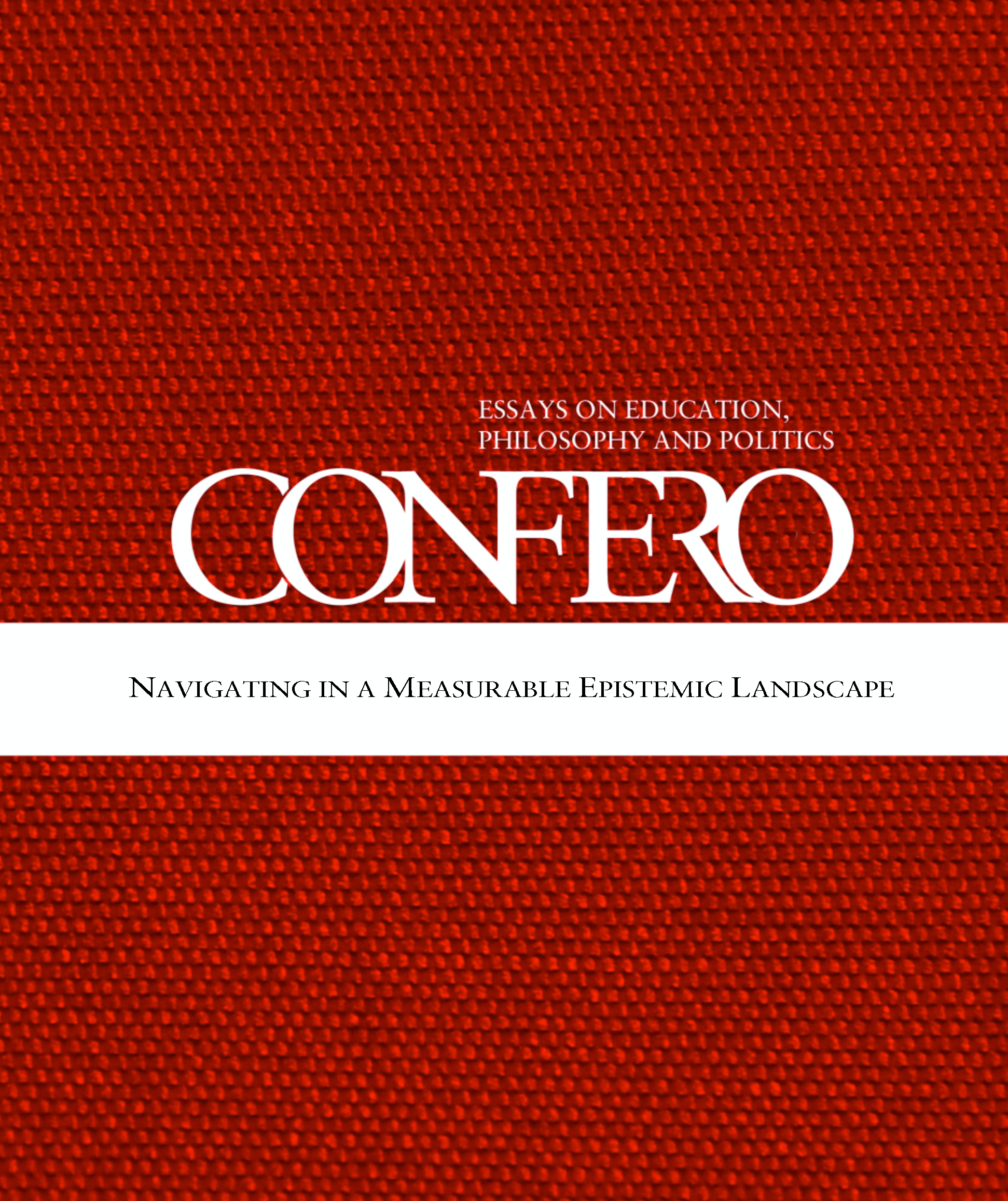The Formation of Thinking
DOI:
https://doi.org/10.3384/confero.2001-4562.200616Abstract
In recent years, we have seen examples of how political leaders, such as Bolsonaro in Brazil or Orbán in Hungary, have controlled and restricted the freedom of the university in a way that frightens us and reminds us of the inherent fragility of our own societies. However horrible these political acts are, I would like to claim that there is a danger in letting oneself be hypnotized by those who hold political power and who, through dramatic gestures and authoritarian rule, suffocate free thought. Equally important is to pay attention to the slow and barely noticed political processes in which, through government directives and reforms based on economically motivated ideas about efficiency and employability, officials and authorities limit the freedom of higher education. An example of such a process I would like to scrutinize is how thinking came to be regarded as a generic skill in the Western education system.
References
Arendt, H. (2003) Thinking and moral considerations in Kohn, J. (ed.) Responsibility and Judgement. New York: Shocken Books.
Arendt, H. (1963). Eichmann in Jerusalem: a report on the banality of evil. New York: Viking Press.
Bejerot, E. & Hasselbladh, H. (2002). Kvalitet utan gränser: en kritisk belysning av kvalitetsstyrning. Lund: Academia Adacta
Biggs J. & Tang J. (2007) Teaching for Quality Learning at University, New York: Open University Press.
Bloom, H. (1987) The Closing of the American Mind: How Higher Education Has Failed Democracy and Impoverished Souls of Todays Students. Simon and Schustet.
Bohlin, H. (2008) Bildung and Moral Self-Cultivation in Higher Education: What Does it Mean and How Can it be Achieved?. Forum on Public Policy. N. 2.
Bornemark, J. (2018). The Limits of Ratio: An Analysis of NPM in Sweden using Nicholas of Cusas Understanding of Reason in Ajana, B (ed.) Metric Culture: Ontologies of Self-Tracking Practices. Emerald Publishing. https://doi.org/10.1108/978-1-78743-289-520181013
Dewey, J. (2007). Democracy and education. [Sioux Falls, S.D.]: NuVision Publications.
Dewey, J. (2005). Art as Experience. London: The Berkeley Publishing group.
Dewey, J. (1986). The later works, 1925-1953. Vol. 8, 1933: essays and How we think, revised edition. Boydston, J.A. (ed). Carbondale, Ill.: Southern Illinois University Press.
Gustavsson, B. (2009) Utbildningens förändrade villkor. Stockholm: Liber
Gustavsson, B. (2007) (ed.) Bildningens förvandlingar, Göteborg: Daidalos.
Hegel, G.W.F. (1986). Enzyklopädie der philosophischen Wissenschaften 1, Werke 8, Frankfurt am Main: Suhrkamp.
Hood, C. & Dixon, R. (2015). A Government that Worked Better and Cost Less?:Evaluating Three Decades of Reform and Change in UK Central Government. Oxford: Oxford University Press. https://doi.org/10.1093/acprof:oso/9780199687022.001.0001
Humboldt, W. V. (1960). Theorie der Bildung des Menschen, Werke in funf Bänden. Darmstadt: Wissenschaftl. Buchgesellschaft.
Kierkegaard, S. (1985). Philosophical Fragments, Hong E. & Hong V ed. & trans. Princeton New Jersey: Princeton University Press.
Lindgren, L. (2006). Utvärderingsmonstret: kvalitets- och resultatmätning i den offentliga sektorn. Lund: Studentlitteratur
McGuinness, C. (1999) From Thinking Skills to Thinking Classrooms: A Review and Evalutation of Approaches for Developing Pupils Thinking. Departement for Education and Skills (DfEE) report.
Ostermann, H, (2002) Rotten at the Core? The Higher Education Debate in Germany, German Politics, 11:1, 43-60 https://doi.org/10.1080/714001233
Trow, M. (1973) Problems in the Transition from Elite to Mass Higher Education.Berkely, CA: Carneige Commission on Higher Education.
Trow, M. (2006) Reflections on the Transition from Elite to Mass to Universal Access: Forms and Phases of Higher Education in Modern Societies since WWII. International Handbook of Higher Education: Global Themes and Contemporary Challenges. Dordrecht: Springer.
Winch, C. (ed.) (2010) Teaching Thinking Skills (London & New York: Key Debates in Educational Policy, 2010).
Websites
The Bologna Declaration 19 June 1999
Curriculum for the Preschool (Lpfö 98)
(https://theinternationalpreschool.se/sites/default/files/documents/lpfo98_re2010_english.pdf)
Curriculum for the compulsory school, preschool class and school-age educare (Lgr 11)
(https://www.skolverket.se/getFile?file=3984)
Curriculum for the upper secondary school (Lgy 11)
(https://www.skolverket.se/getFile?file=2975)
The Higher Education Ordinance 1993: 100
(https://www.uhr.se/en/start/laws-and-regulations/laws-andregulations/the-higher-education-ordinance/ ) (Högskoleförordning 1993: 100
Högskoleverkets rapportserie 2001:10 R. Internationell jämförbarhet och styrning – aktuella perspektiv på högskolans examensordning. Högskoleverket.
Högskoleverkets rapportserie 2001:2 R Minskad tillströmning till högre utbildning – analys och diskussion om möjliga orsaker. Högskoleverket.
(https://www.uka.se/download/18.12f25798156a345894e2903/1487841888558/0742R.pdf)
NSHU (Swedish Agency for Networks and Cooperation in Higher Education [Myndigheten för nätverk och samarbete inom högre utbildning]”Att skriva förväntade studieresultat. Stöd förförväntade studieresultat på kursnivå”. This material was produced within the project ”Webbaserad kvalitetsstöd för högskolornas pedagogiska arbete kring lärandemål, examination och läraktiviteter”. 2006-10-11”.
(http://www.kursutveckling.se/dok/nshu_Larandemal_061011.pdf)
Regeringens Proposition 2006/07:107. Vägar till högskolan för kunskap och kvalitet
https://filedn.com/ljdBas5OJsrLJOq6KhtBYC4/forarbeten/prop/2006-07/prop-2006-07-107.pdf
Stockholm University (2018). Samhällsvetenskapliga fakulteten. ”Riktlinjer för kursplaner för kurser på grundnivå och avancerad nivå vid Samhällsvetenskapliga fakulteten”.
Södertörn University (2010). ”Riktlinjer för upprättande av kurs- ochutbildningsplaner vid Södertörns högskola.”
Utbildningsdepartementet, pressrelease June 21 2006:
Downloads
Published
Issue
Section
License
Copyright (c) 2020 Jonna Hjertström Lappalainen

This work is licensed under a Creative Commons Attribution 4.0 International License.
As Confero is an open access journal, this means that anyone who can access the Internet can freely download and read the journal. There are no commercial interests for Linköping University Electronic Press or Confero in publishing the journal.
The core idea of open access is that copyright remains with the author(s). However, we publish with the agreement of the author that if she or he decides later to publish the article elsewhere, that the publisher will be notified, prior to any acceptance, that the article has already been published by Confero.
When publishing with Confero, it is with the agreement of the author that if they make their article available elsewhere on the internet (for example, on their own website or an institutional website), that they will do so by making a link to the article as published in Confero using the Digital Object Identifier (DOI) number of the article and acknowledge in the text of the site that the article has been previously published in Confero.
As evident by the markers on our homepage, Confero falls under the Creative Commons licence abbreviated BY. This means that we allow others to use, spread and elaborate on the published articles, as long as they acknowledge who published it and where it was originally published.



